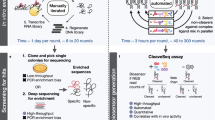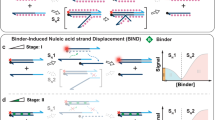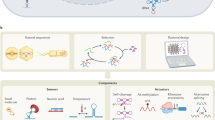Abstract
Allosteric RNA devices are increasingly being viewed as important tools capable of monitoring enzyme evolution, optimizing engineered metabolic pathways, facilitating gene discovery and regulators of nucleic acid–based therapeutics. A key bottleneck in the development of these platforms is the availability of small-molecule-binding RNA aptamers that robustly function in the cellular environment. Although aptamers can be raised against nearly any desired target through in vitro selection, many cannot easily be integrated into devices or do not reliably function in a cellular context. Here, we describe a new approach using secondary- and tertiary-structural scaffolds derived from biologically active riboswitches and small ribozymes. When applied to the neurotransmitter precursors 5-hydroxytryptophan and 3,4-dihydroxyphenylalanine, this approach yielded easily identifiable and characterizable aptamers predisposed for coupling to readout domains to allow engineering of nucleic acid–sensory devices that function in vitro and in the cellular context.
This is a preview of subscription content, access via your institution
Access options
Access Nature and 54 other Nature Portfolio journals
Get Nature+, our best-value online-access subscription
$29.99 / 30 days
cancel any time
Subscribe to this journal
Receive 12 print issues and online access
$259.00 per year
only $21.58 per issue
Buy this article
- Purchase on Springer Link
- Instant access to full article PDF
Prices may be subject to local taxes which are calculated during checkout





Similar content being viewed by others
References
Darmostuk, M., Rimpelova, S., Gbelcova, H. & Ruml, T. Current approaches in SELEX: an update to aptamer selection technology. Biotechnol. Adv. 33, 1141–1161 (2015).
McKeague, M. & Derosa, M.C. Challenges and opportunities for small molecule aptamer development. J. Nucleic Acids 2012, 748913 (2012).
Berens, C., Thain, A. & Schroeder, R. A tetracycline-binding RNA aptamer. Bioorg. Med. Chem. 9, 2549–2556 (2001).
Jenison, R.D., Gill, S.C., Pardi, A. & Polisky, B. High-resolution molecular discrimination by RNA. Science 263, 1425–1429 (1994).
Paige, J.S., Wu, K.Y. & Jaffrey, S.R. RNA mimics of green fluorescent protein. Science 333, 642–646 (2011).
Berens, C., Groher, F. & Suess, B. RNA aptamers as genetic control devices: the potential of riboswitches as synthetic elements for regulating gene expression. Biotechnol. J. 10, 246–257 (2015).
Sharma, V., Nomura, Y. & Yokobayashi, Y. Engineering complex riboswitch regulation by dual genetic selection. J. Am. Chem. Soc. 130, 16310–16315 (2008).
Garst, A.D., Edwards, A.L. & Batey, R.T. Riboswitches: structures and mechanisms. Cold Spring Harb. Perspect. Biol. 3, a003533 (2011).
Barrick, J.E. & Breaker, R.R. The distributions, mechanisms, and structures of metabolite-binding riboswitches. Genome Biol. 8, R239 (2007).
Kellenberger, C.A., Wilson, S.C., Sales-Lee, J. & Hammond, M.C. RNA-based fluorescent biosensors for live cell imaging of second messengers cyclic di-GMP and cyclic AMP-GMP. J. Am. Chem. Soc. 135, 4906–4909 (2013).
Ketterer, S., Gladis, L., Kozica, A. & Meier, M. Engineering and characterization of fluorogenic glycine riboswitches. Nucleic Acids Res. 44, 5983–5992 (2016).
Su, Y., Hickey, S.F., Keyser, S.G. & Hammond, M.C. In vitro and in vivo enzyme activity screening via RNA-based fluorescent biosensors for S-adenosyl-l-homocysteine (SAH). J. Am. Chem. Soc. 138, 7040–7047 (2016).
Romanini, D.W., Peralta-Yahya, P., Mondol, V. & Cornish, V.W. A heritable recombination system for synthetic Darwinian evolution in yeast. ACS Synth. Biol. 1, 602–609 (2012).
Davis, J.H. & Szostak, J.W. Isolation of high-affinity GTP aptamers from partially structured RNA libraries. Proc. Natl. Acad. Sci. USA 99, 11616–11621 (2002).
Filonov, G.S., Moon, J.D., Svensen, N. & Jaffrey, S.R. Broccoli: rapid selection of an RNA mimic of green fluorescent protein by fluorescence-based selection and directed evolution. J. Am. Chem. Soc. 136, 16299–16308 (2014).
Peselis, A. & Serganov, A. Structure and function of pseudoknots involved in gene expression control. Wiley Interdiscip. Rev. RNA 5, 803–822 (2014).
de la Peña, M., Dufour, D. & Gallego, J. Three-way RNA junctions with remote tertiary contacts: a recurrent and highly versatile fold. RNA 15, 1949–1964 (2009).
Nakayama, S., Luo, Y., Zhou, J., Dayie, T.K. & Sintim, H.O. Nanomolar fluorescent detection of c-di-GMP using a modular aptamer strategy. Chem. Commun. (Camb.) 48, 9059–9061 (2012).
Wittmann, A. & Suess, B. Selection of tetracycline inducible self-cleaving ribozymes as synthetic devices for gene regulation in yeast. Mol. Biosyst. 7, 2419–2427 (2011).
Mandal, M., Boese, B., Barrick, J.E., Winkler, W.C. & Breaker, R.R. Riboswitches control fundamental biochemical pathways in Bacillus subtilis and other bacteria. Cell 113, 577–586 (2003).
Sudarsan, N. et al. Riboswitches in eubacteria sense the second messenger cyclic di-GMP. Science 321, 411–413 (2008).
Khvorova, A., Lescoute, A., Westhof, E. & Jayasena, S.D. Sequence elements outside the hammerhead ribozyme catalytic core enable intracellular activity. Nat. Struct. Biol. 10, 708–712 (2003).
Majerfeld, I., Puthenvedu, D. & Yarus, M. RNA affinity for molecular l-histidine; genetic code origins. J. Mol. Evol. 61, 226–235 (2005).
Marshall, K.A. & Ellington, A.D. In vitro selection of RNA aptamers. Methods Enzymol. 318, 193–214 (2000).
Illangasekare, M., Turk, R., Peterson, G.C., Lladser, M. & Yarus, M. Chiral histidine selection by d-ribose RNA. RNA 16, 2370–2383 (2010).
Wilkinson, K.A., Merino, E.J. & Weeks, K.M. Selective 2′-hydroxyl acylation analyzed by primer extension (SHAPE): quantitative RNA structure analysis at single nucleotide resolution. Nat. Protoc. 1, 1610–1616 (2006).
Joyce, G.F. Directed evolution of nucleic acid enzymes. Annu. Rev. Biochem. 73, 791–836 (2004).
Mohr, S. et al. Thermostable group II intron reverse transcriptase fusion proteins and their use in cDNA synthesis and next-generation RNA sequencing. RNA 19, 958–970 (2013).
Carothers, J.M., Goler, J.A., Kapoor, Y., Lara, L. & Keasling, J.D. Selecting RNA aptamers for synthetic biology: investigating magnesium dependence and predicting binding affinity. Nucleic Acids Res. 38, 2736–2747 (2010).
Ditzler, M.A. et al. High-throughput sequence analysis reveals structural diversity and improved potency among RNA inhibitors of HIV reverse transcriptase. Nucleic Acids Res. 41, 1873–1884 (2013).
Schütze, T. et al. Probing the SELEX process with next-generation sequencing. PLoS One 6, e29604 (2011).
Majerfeld, I. & Yarus, M. A diminutive and specific RNA binding site for l-tryptophan. Nucleic Acids Res. 33, 5482–5493 (2005).
Yao, Z., Weinberg, Z. & Ruzzo, W.L. CMfinder: a covariance model based RNA motif finding algorithm. Bioinformatics 22, 445–452 (2006).
Weinberg, Z. & Breaker, R.R. R2R: software to speed the depiction of aesthetic consensus RNA secondary structures. BMC Bioinformatics 12, 3 (2011).
Merino, E.J., Wilkinson, K.A., Coughlan, J.L. & Weeks, K.M. RNA structure analysis at single nucleotide resolution by selective 2′-hydroxyl acylation and primer extension (SHAPE). J. Am. Chem. Soc. 127, 4223–4231 (2005).
Stoddard, C.D., Gilbert, S.D. & Batey, R.T. Ligand-dependent folding of the three-way junction in the purine riboswitch. RNA 14, 675–684 (2008).
Garst, A.D., Porter, E.B. & Batey, R.T. Insights into the regulatory landscape of the lysine riboswitch. J. Mol. Biol. 423, 17–33 (2012).
Batey, R.T., Gilbert, S.D. & Montange, R.K. Structure of a natural guanine-responsive riboswitch complexed with the metabolite hypoxanthine. Nature 432, 411–415 (2004).
Krasilnikov, A.S. & Mondragón, A. On the occurrence of the T-loop RNA folding motif in large RNA molecules. RNA 9, 640–643 (2003).
Edwards, T.E. & Ferré-D'Amaré, A.R. Crystal structures of the thi-box riboswitch bound to thiamine pyrophosphate analogs reveal adaptive RNA-small molecule recognition. Structure 14, 1459–1468 (2006).
Serganov, A., Polonskaia, A., Phan, A.T., Breaker, R.R. & Patel, D.J. Structural basis for gene regulation by a thiamine pyrophosphate-sensing riboswitch. Nature 441, 1167–1171 (2006).
Nagaswamy, U. & Fox, G.E. Frequent occurrence of the T-loop RNA folding motif in ribosomal RNAs. RNA 8, 1112–1119 (2002).
Stojanovic, M.N. & Kolpashchikov, D.M. Modular aptameric sensors. J. Am. Chem. Soc. 126, 9266–9270 (2004).
Ponchon, L. & Dardel, F. Recombinant RNA technology: the tRNA scaffold. Nat. Methods 4, 571–576 (2007).
Kellenberger, C.A., Chen, C., Whiteley, A.T., Portnoy, D.A. & Hammond, M.C. RNA-based fluorescent biosensors for live cell imaging of second messenger cyclic di-AMP. J. Am. Chem. Soc. 137, 6432–6435 (2015).
Buck, J., Noeske, J., Wöhnert, J. & Schwalbe, H. Dissecting the influence of Mg2+ on 3D architecture and ligand-binding of the guanine-sensing riboswitch aptamer domain. Nucleic Acids Res. 38, 4143–4153 (2010).
Hodak, J.H., Downey, C.D., Fiore, J.L., Pardi, A. & Nesbitt, D.J. Docking kinetics and equilibrium of a GAAA tetraloop-receptor motif probed by single-molecule FRET. Proc. Natl. Acad. Sci. USA 102, 10505–10510 (2005).
Caporaso, J.G. et al. QIIME allows analysis of high-throughput community sequencing data. Nat. Methods 7, 335–336 (2010).
Edgar, R.C. Search and clustering orders of magnitude faster than BLAST. Bioinformatics 26, 2460–2461 (2010).
Edgar, R.C. MUSCLE: multiple sequence alignment with high accuracy and high throughput. Nucleic Acids Res. 32, 1792–1797 (2004).
Edwards, A.L., Garst, A.D. & Batey, R.T. Determining structures of RNA aptamers and riboswitches by X-ray crystallography. Methods Mol. Biol. 535, 135–163 (2009).
Das, R., Laederach, A., Pearlman, S.M., Herschlag, D. & Altman, R.B. SAFA: semi-automated footprinting analysis software for high-throughput quantification of nucleic acid footprinting experiments. RNA 11, 344–354 (2005).
Gilbert, S.D. & Batey, R.T. Monitoring RNA-ligand interactions using isothermal titration calorimetry. Methods Mol. Biol. 540, 97–114 (2009).
Pflugrath, J.W. The finer things in X-ray diffraction data collection. Acta Crystallogr. D Biol. Crystallogr. 55, 1718–1725 (1999).
Adams, P.D. et al. PHENIX: a comprehensive Python-based system for macromolecular structure solution. Acta Crystallogr. D Biol. Crystallogr. 66, 213–221 (2010).
Emsley, P. & Cowtan, K. Coot: model-building tools for molecular graphics. Acta Crystallogr. D Biol. Crystallogr. 60, 2126–2132 (2004).
Chen, V.B. et al. MolProbity: all-atom structure validation for macromolecular crystallography. Acta Crystallogr. D Biol. Crystallogr. 66, 12–21 (2010).
Paige, J.S., Nguyen-Duc, T., Song, W. & Jaffrey, S.R. Fluorescence imaging of cellular metabolites with RNA. Science 335, 1194 (2012).
Schindelin, J. et al. Fiji: an open-source platform for biological-image analysis. Nat. Methods 9, 676–682 (2012).
Acknowledgements
The authors thank B. Suess (Technical University Darmstadt) and A. Heckel (Goethe University Frankfurt) for the kind gift of α-methyl-5-hydroxy-L-tryptophan, R. Knight and J. Shorenstein for useful discussions about bioinformatics analysis of selections, A. Lambowitz (University of Texas at Austin) for the generous gift of the GsI reverse transcriptase, M. Yarus for the amino acid column labeling protocol, D. McKay and J. Trausch for crystallographic support, and A. Young and A. Palmer for assistance with microscopy. J. Kieft, J. Pfingsten and M. Matyjasik provided critical feedback on the manuscript. This work was supported by grants to R.T.B. from the National Science Foundation (NSF 1150834) and the National Institutes of Health (R01 GM073850) and a predoctoral training grant in Signaling and Cellular Regulation (T32 GM008759).
Author information
Authors and Affiliations
Contributions
E.B.P. conceived the project and either performed or participated in all experiments and in writing of the manuscript. J.T.P. performed the 5HTP and L-DOPA sensor construction, assay and interpretation. M.M.M. participated in the GR/SSIII selection, screened for crystals of the 5GR-II–5HTP complex and collected crystallographic data. R.T.B. oversaw the project, including planning of experiments, interpretation of data and writing of the manuscript.
Corresponding author
Ethics declarations
Competing interests
The authors declare no competing financial interests.
Supplementary information
Supplementary Text and Figures
Supplementary Results, Supplementary Tables 1–7 and Supplementary Figures 1–14 (PDF 11175 kb)
Supplementary Data
Representative sequences from clusters defining eight 5-hydroxytryptophan binding aptamers (5HTP) and four 3,4-dihydroxyphenylalanine binding aptamers (3,4-DHF). (ZIP 331 kb)
Rights and permissions
About this article
Cite this article
Porter, E., Polaski, J., Morck, M. et al. Recurrent RNA motifs as scaffolds for genetically encodable small-molecule biosensors. Nat Chem Biol 13, 295–301 (2017). https://doi.org/10.1038/nchembio.2278
Received:
Accepted:
Published:
Issue Date:
DOI: https://doi.org/10.1038/nchembio.2278
This article is cited by
-
Microfluidics-driven high-throughput phenotyping and screening in synthetic biology: from single cells to cell-free systems
Biotechnology and Bioprocess Engineering (2024)
-
The fluorescent aptamer Squash extensively repurposes the adenine riboswitch fold
Nature Chemical Biology (2022)
-
Repurposing an adenine riboswitch into a fluorogenic imaging and sensing tag
Nature Chemical Biology (2022)
-
RNA origami design tools enable cotranscriptional folding of kilobase-sized nanoscaffolds
Nature Chemistry (2021)
-
A multiplexed, automated evolution pipeline enables scalable discovery and characterization of biosensors
Nature Communications (2021)



